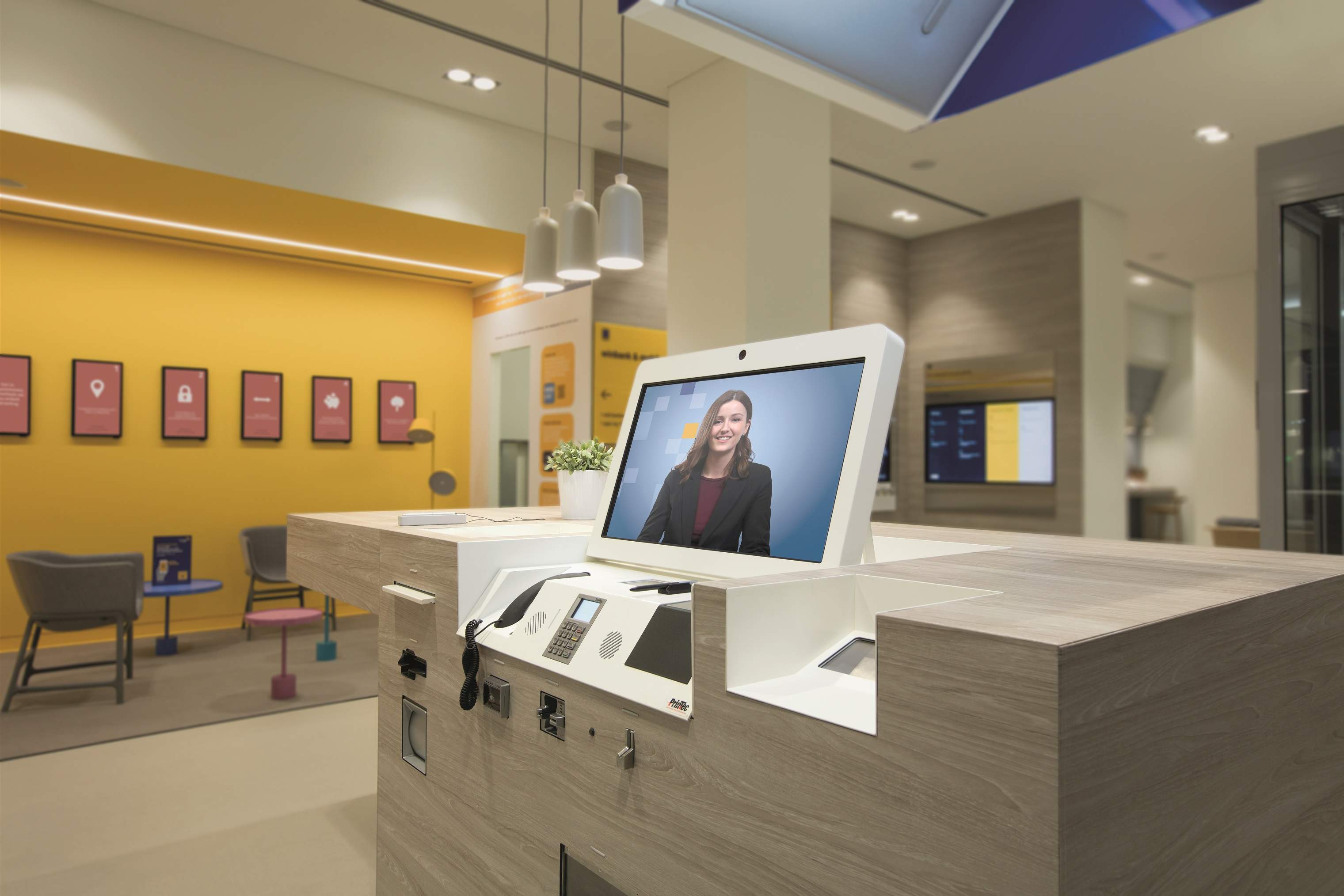
Piraeus Bank has opened three fully automated e-branches, the first of their kind in Greece. Eftichia Kasselaki, head of retail banking at Piraeus, tells Douglas Blakey how the new digital bank format represents the most exciting recent innovation in Greek retail banking
The concept of the digital bank branch combining the latest technology and a friendly environment to create a modern banking experience is not new.
How well do you really know your competitors?
Access the most comprehensive Company Profiles on the market, powered by GlobalData. Save hours of research. Gain competitive edge.

Thank you!
Your download email will arrive shortly
Not ready to buy yet? Download a free sample
We are confident about the unique quality of our Company Profiles. However, we want you to make the most beneficial decision for your business, so we offer a free sample that you can download by submitting the below form
By GlobalDataBest-of-class examples include CIBC’s work with allen international to craft a state-of-the-art design template for future full-service and small teller-free local branches.
Other notable examples include Bank Hapoalim’s digital branch in Tel Aviv, BMO’s Smart Branches, Standard Chartered’s digital branches in Pakistan, Kenya and elsewhere, and in Europe, mBank’s much-lauded digital outlets.
But in Greece, Piraeus can claim a notable first with the launch of what it terms e-branches.
RBI spoke with Eftichia Kasselaki, executive general manager, retail banking, branch network and deposits at Piraeus Bank, about the thinking behind the new branch concept.

RBI: Can you give some background to the launch of Piraeus e-branches? What was the bank looking to achieve – for example boost digital banking adoption rates, reduce costs?
Eftichia Kasselaki: Piraeus Bank decided to launch a new model of fully automated e-branches in the Greek market, as a result of its business strategy to adopt innovative and modern ways of improving customer service. The e-branch concept aims to improve the overall experience of its customers through the provision of pioneering services, in a friendly and appealing environment.
E-branch was born out of worldwide research and aims to bridge the gap between physical branches and online and mobile-based banking.
How do the new branches meet the combined needs of retail and business consumers? Can you summarise the digital technologies and features of the branches?
One of e-branch’s primary objectives is to decongest nearby Piraeus Bank branches by enabling individuals and businesses to carry out over 90% of all transactions via the remote cashier desk securely and quickly. E-branches also offer extended opening hours on weekdays and on Saturdays.
The e-branches currently cater to high-volume, small-value transactions, but Piraeus Bank is working on introducing higher-value business, such as mortgages via the remote cashier.
There are facilitators present at every e-branch during operating hours, who can help customers get acquainted with the technology and digital services of the bank. The hope is that by offering digital training at the e-branches, the daily routine of banking tasks will become much easier and simpler for customers.
And these branches will also surely boost financial inclusion?
Elderly customers in Greece are particularly wary of digital banking, but find the mix of personalised, automated banking in a bricks-and-mortar setting very reassuring – the branches have hosts on hand to assist customers, and the response has been hugely positive.
The remote cashier service has specifically promoted financial inclusion. For example, customers who are visually impaired are able to bank independently and securely in an e-branch. Piraeus Bank has been working closely with Greek charities to raise awareness of the e-branch and further tailor e-branch services.
In-branch meeting rooms will soon offer remote banking services via video link with a call centre. Currently Piraeus customers can use the meeting rooms for free, for example local SMEs.
Which services are offered by the video teller – for example cash deposit and withdrawal, cheque deposit, bill payments?
The remote cashier in every e-branch is one of the greatest innovations in the Greek banking market. It allows banking customers to carry out over 90% of all transactions of a conventional cashier desk through a video call with the assistance of a specially trained cashier.
The transactions that can be carried out range from cash withdrawals and deposits, balance updates, cheque deposits, money transfers for suppliers’ payments, payments of bills and business debts to payments of corporate cards and loans.
Agenda 2020
The Piraeus turnaround programme is built on four key aims: to reduce non-performing debt, cut costs, strengthen its capital base and become independent of emergency liquidity.
Bad debts remain an issue across the sector. The four Greek banks wrote off around €2.5bn ($2.94bn) in total in 2016, and almost another €2bn in the first half of 2017.
Piraeus aims to slash problem loans from €33bn in March to below €20bn by 2020. Its Agenda 2020 turnaround plan aims to reduce non-performing loans from the current eye-watering rate of 38% to below 15%.
Other 2020 targets include an increase number of transactions to be migrated to ATMs: It wants deposits to increase from 40% now to 50% via ATMs by 2020.
Online targets include an increase in customers’ bill payments made online, from a current 60% to 80% by 2020.
Can you comment on the bank’s partners in the project?
We deployed Ailleron’s LiveBank technology. LiveBank was a reliable solution with active implementations. They co-operated well with us, and they were a good partner for the project.
The bank also worked with DINN! In the design on the branches. The aim of this innovative banking concept was to combine technology with everyday life, in a homely landscape design.
We worked with DINN! on a complete programme of branch transformation and have already won international awards for the work on the digital e-branch concept: two awards at the Retail Interiors Awards [gold awards in Design and Technology and for Best Interior – Non-Food Retail] and a Global Banking and Finance award as Most Innovative E-branch Project, Greece 2017.
Despite its complexity, the e-branch project was successfully completed in less than a year, between March and December 2016, with the participation of most of the bank’s departments, supporting partners and vendors.
How do the e-branches’ opening hours compare to traditional branches?
E-branches have longer opening hours: weekdays 9am to 9pm (compared to 8.30am to 2:30pm for traditional branches) and Saturdays 10am to 5pm. Some competitors’ traditional branches are open on Saturdays but not until 9pm on weekdays, so this is a clear point of differentiation.
Greek SMEs tend to be cash-oriented and benefit from the automated services and extended banking hours. Most branches in Greece are closed on a Saturday, or close early, so the e-branches offer added security for these businesses if they can deposit cash at the close of business on a Saturday evening.
How do the operating costs compare with traditional branches? And what sort of KPIs are you using?
Operating costs are significantly lower [in the order of 30%] than a traditional branch, although initial investment is higher.
The e-branches aim to serve customers who are reluctant to switch their transactions to online channels in one go, customers with special needs – for example hearing or sight impaired – as well as local businesses that may have special needs, such as coin, cash or cheque handling. We have specific internal KPIs to measure progress on all of these.
Indicatively, we currently perform as many transactions in our e-branches as a nearby traditional branch. Eighty percent of target customers were non-digitally savvy people: one-third of people using the remote cashier are over 60 years old – they previously only used physical branches.
What has been the early response from customers and your bank colleagues to the new concept?
During the short period of its operation, the e-branch has already been accepted with great enthusiasm by a large number of individuals as well as business representatives.
Customers of all ages, even elderly people with no digital skills, have praised the friendly, homely design and welcoming atmosphere of the new digital branch. They are thrilled by the simplicity of the transactions offered, even when using remote cashier, our pioneering video banking service.
So we can expect to see an expanding number of e-branches?
Piraeus Bank has already begun research on the next possible location to expand the network of its digital branches, and hopes to open one or two new e-branches by the end of 2017.
Piraeus now has the largest branch network in Greece with about 660 branches, some way ahead of your closest rivals – that is quite a change compared to the position prior to the banking crisis?
Piraeus also has the greater market share in deposits and loans and serves more than 4.7 million customers across Greece. The implementation of a hub-and-spoke distribution model is part of a broader Retail Transformation Programme which aims to increase the overall effectiveness and efficiency of this line of business.
Through this model, we manage to do “more with less”, thus ending up with reduced operating costs but increased coverage and customer experience levels, giving emphasis to the most valuable client base.
Of Piraeus’s 4.7 million customers, only around 1.5 million are using digital channels currently, so is there great scope to grow this number?
Piraeus Bank’s online banking service, Winbank, is one of the best digital banking services in the Greek market. It is also the most modern from a user’s interface perspective, adapting to the screen size of the user’s browser, making it compatible with any screen size or device.
The mobile app offers clear and concise usability, making customers feel confident in managing their financial products online.

Piraeus transformation gathers speed
Ahead of the Greek economic crisis, Piraeus ranked only fourth-largest lender in Greece. Today, by all key banking metrics it ranks first.
After a series of mergers and bank failures, the Greek banking sector is now heavily consolidated and comprises four systemic lenders: National Bank of Greece, Alpha, Eurobank and Piraeus. Greece’s bank rescue fund, HFSF, currently owns about 26% of Piraeus.
Piraeus Bank’s energetic CEO Christos Megalou is a man in a hurry. Appointed in March this year – the lender’s third CEO in just two years – he has said he will offload €4bn of bad loans by the year-end.
As part of an ambitious bank restructuring plan, he has also said Piraeus will repay state aid “as soon as possible”.
Since 2015, Greek government aid to Piraeus totals around €2.7bn. Piraeus has accelerated sales of bad debts, in particular troubled loans in Serbia, Bulgaria and Romania.
In a July interview with Bloomberg, an upbeat Megalou said that Piraeus would reduce its non-performing loans to €19.1bn by the end of the year from €23bn in March.
Megalou previously led rival Eurobank. He was widely praised for the successful turnaround at Eurobank, in particular its success in becoming the first Greek bank to return to the private sector after the crisis.
While it is early days, the market clearly approves of the Megalou appointment.
The Piraeus share price is up 55% to around €11.50 in mid-August since his appointment in early March.
As a whole, the Greek banking sector lost a whopping €70.3bn in pre-tax losses in the six-year period 2010-2015.
Since the start of the banking crisis, employee numbers at Greek banks have reduced by about 20,000, around a 30% reduction in headcount.
Branch numbers across the sector have been slashed by almost 2,000 to total around 2,200.








